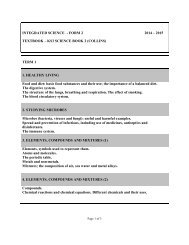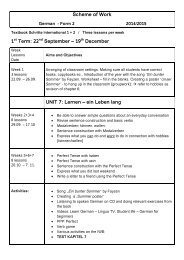Economics Scheme of work for form 4 - St Joseph School, Blata l ...
Economics Scheme of work for form 4 - St Joseph School, Blata l ...
Economics Scheme of work for form 4 - St Joseph School, Blata l ...
Create successful ePaper yourself
Turn your PDF publications into a flip-book with our unique Google optimized e-Paper software.
<strong>St</strong>. <strong>Joseph</strong> <strong>School</strong>, <strong>Blata</strong> l-Bajda <strong>Economics</strong> <strong>Scheme</strong> <strong>of</strong> Work: Form 4 2014-2015<br />
Textbook used:<br />
<strong>Economics</strong> <strong>Scheme</strong> <strong>of</strong> Work <strong>for</strong> Form 4: 2014-2015<br />
Edexcel IGSCE <strong>Economics</strong> – Rob Jones<br />
First term: September – December<br />
Module 1: Production and Productivity<br />
o Fixed and Variable factors <strong>of</strong> production.<br />
o The Short run and the Long run.<br />
o Total Product:<br />
• Meaning, calculation and graph<br />
o Average product<br />
• Meaning, calculation and graph<br />
o Marginal Product<br />
• Meaning, calculation and graph<br />
o The Law <strong>of</strong> Diminishing Marginal Returns<br />
o Costs <strong>of</strong> Production<br />
• Meaning, calculation, graph <strong>of</strong> fixed, variable, total, average and<br />
marginal costs<br />
o Revenue, Pr<strong>of</strong>its, Break-even point<br />
Module 2: Demand & Supply I<br />
o Demand<br />
• The Concept <strong>of</strong> demand<br />
• The law <strong>of</strong> demand<br />
• The demand curve<br />
o Supply<br />
• The Concept <strong>of</strong> supply<br />
• The Law <strong>of</strong> supply<br />
• The supply curve<br />
o Supply & Demand up to equilibrium price<br />
• Excess demand and excess supply<br />
o Equilibrium price<br />
o Factors that effect Demand<br />
o Shifts in demand and the effect on market price and quantity<br />
o Factors that effect Supply<br />
o Shifts in supply and effect on the market<br />
1 Ms. Roberta Darmanin & Ms. Cristina Spiteri
<strong>St</strong>. <strong>Joseph</strong> <strong>School</strong>, <strong>Blata</strong> l-Bajda <strong>Economics</strong> <strong>Scheme</strong> <strong>of</strong> Work: Form 4 2014-2015<br />
Second term: January – April<br />
Module 2: Demand & Supply II<br />
o Price elasticity <strong>of</strong> demand (PED)<br />
• Meaning and <strong>for</strong>mula<br />
• Factors effecting it<br />
• Special cases <strong>of</strong> PED<br />
o Elasticity and Total Revenue<br />
o Income elasticity <strong>of</strong> demand<br />
o Cross elasticity <strong>of</strong> demand<br />
o Price elasticity <strong>of</strong> supply<br />
• Meaning and <strong>for</strong>mula<br />
• Factors effecting it<br />
• Special cases<br />
Module 3: Large and Small firms<br />
o Changing returns to scale<br />
o Internal Economies <strong>of</strong> scale<br />
o Internal Diseconomies <strong>of</strong> scale<br />
o External economies <strong>of</strong> scale<br />
o External diseconomies <strong>of</strong> scale<br />
o Why firms grow<br />
o How firms grow<br />
• Types <strong>of</strong> integration<br />
o Survival <strong>of</strong> small firms<br />
Third term: April – June<br />
Module 4: The <strong>St</strong>ructure <strong>of</strong> the Market<br />
o Overview <strong>of</strong> the market structures<br />
o Perfect Competition<br />
• Its features, advantages and disadvantages<br />
o Monopoly<br />
• Its features, barriers to entry, avantages & disadantages<br />
o Application to real life situations<br />
2 Ms. Roberta Darmanin & Ms. Cristina Spiteri
<strong>St</strong>. <strong>Joseph</strong> <strong>School</strong>, <strong>Blata</strong> l-Bajda <strong>Economics</strong> <strong>Scheme</strong> <strong>of</strong> Work: Form 4 2014-2015<br />
Module 5: Finance continued<br />
o Brief revision <strong>of</strong> topic covered in Form 3<br />
o Definitions <strong>of</strong> money supply, liquidity<br />
o Credit creation<br />
o Sources <strong>of</strong> finance<br />
o Role <strong>of</strong> MFSA<br />
Module 6: Privitatisation<br />
o Nationalisation<br />
• Meaning, pros and cons<br />
o Privatisation<br />
• Meaning, pros and cons<br />
o Reference to the Maltese economy<br />
Module 7: Location <strong>of</strong> Industry<br />
o Revision on types <strong>of</strong> industry<br />
o Factors that effect choice <strong>of</strong> location<br />
o Weight losing, weight gaining, footloose industries<br />
o Regional policy<br />
o Role <strong>of</strong> MEPA & Malta Enterprise<br />
Module 8: The Role <strong>of</strong> Trade Unions<br />
o Different types <strong>of</strong> trade unions<br />
o Employers’ Associations<br />
o The Employment and Industrial Relations Act<br />
Module 9: The Production Possibility Curve<br />
o Meaning <strong>of</strong> production possibility curve<br />
o How to draw and interpret one.<br />
3 Ms. Roberta Darmanin & Ms. Cristina Spiteri

















